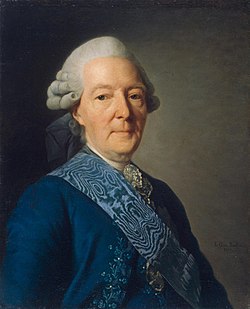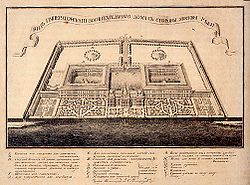Ivan Betskoy

Saint Petersburg,Hermitage Museum
Ivan Ivanovich BetskoiorBetskoy(Russian:Ива́н Ива́нович Бе́цкой;14 February [O.S.3 February] 1704 – 11 September [O.S.31 August] 1795) was an educational reformer in theRussian Empirewho served asCatherine II's advisor on education and President of theImperial Academy of Artsfor thirty years (1764–1794). Perhaps the crowning achievement of his long career was the establishment ofRussia's first unified systemofpublic education.
Life
[edit]Betskoy's parents were PrinceIvan Trubetskoy,a Russian field marshal, and his Swedish mistress, Baroness vonWrede.His surname is the abbreviated form of his father's - a tradition forRussian surnames of illegitimate children.
He was born inStockholm,where Trubetskoy was held captive throughout theGreat Northern War,and went toCopenhagento get a military education before joining a Danish cavalry regiment. It was in the Danish service that he sustained a fall from a horse which forced him to retire from the service. Field Marshal Trubetskoy, having no other sons but Betskoy, called him to the Russian Empire in 1729. At first he served as his father'saide-de-campbut later would be sent on diplomatic missions to various capitals of Europe.
Betskoy was actively involved in acoup d'etatthat broughtElizaveta Petrovnato the Russian throne. The grateful empress promoted him to General Major and asked him to attendJoanna Elisabeth of Holstein-Gottorp,whose daughter Catherine was selected as a bride for the Empress' nephew and heir, Grand Duke Peter. In truth, Betskoy had been on friendly terms with Johanna Elisabeth for two decades previous, their intimacy giving rise to rumours that Catherine was his biological daughter.

After Johanna Elisabeth was expelled from Russia in 1747, Betskoy found it necessary to lay down his offices and settle inParis,where he spent the following 15 years in commerce with theEncyclopédistesespecially toJean-Jacques Rousseau.And toDenis Diderot,he was at least in correspondence with him. He was introduced to the highest echelons of the French aristocracy by his half-sister PrincessAnastasia Ivanovna, Landgravine von Hesse-Homburg(her first husband was PrinceDemetre Cantemir,ruler ofMoldavia).
Peter III of Russiarecalled Betskoy to Russia and put him in charge of imperial palaces and gardens. Upon arriving to Saint Petersburg, Betskoy renewed his acquaintance with the sovereign's wife (and his own purported daughter), helping her depose Peter in 1762. His hopes to profit from his prominent share in the conspiracy were high. In her memoirs,Ekaterina Dashkovarecalls an episode when Betskoy importuned the Empress with questions like "Was I not the one who incited the Guards? Was I not the one who threw money to the people?"

Although Betskoy held no post of any consequence until 1764, when Catherine made him President of the Imperial Academy of Arts, he went on to become a pillar of the Russian establishment. His position at Catherine's court is not easy to classify. Some historians define his post as a "personal secretary"; others regard Betskoy as an "unofficial education minister" to the Empress. He was one of the few people who enjoyed unlimited access to the Tsarina on daily basis for most of her reign. It was at his suggestion thatÉtienne Maurice Falconetwas commissioned to sculpt theBronze Horseman;and it was he who engagedGeorg von Veldtento design a magnificent iron fence for theSummer Garden.
Betskoy's influence continued unabated until the late 1780s when Catherine's tolerance towards the ideas of the Enlightenment began to be eroded and Betskoy was declared "reverting to childhood" on account of his advanced age. Death overtook him in his ninety-second year, when he had long been incapacitated by blindness. Betskoy never married and left his estates to a natural daughter who enjoyed Catherine's particular favour; she marriedJose de Ribas,a Spanish adventurer who founded the city ofOdessa.
Educational reform
[edit]
In 1763, Betskoy presented to Catherine theStatute for the Education of the Youth of Both Sexes,studded with citations fromComenius,John Locke,and Rousseau. The treatise contained a proposal to educate young Russians of both sexes in stateboarding schools,aimed at creating "a new race of men". Betskoy set forth a number of arguments for general education of children rather than specialized one: "in regenerating our subjects by an education founded on these principles, we will create... new citizens." Boarding schools were to be preferred to other institutions of education in accordance with Rousseau's notion that "isolating the pupils enabled their tutors to protect them from the vices of society."[2]
The Empress endorsed his proposal and established theSociety for the Training of Well-Born Girls,with Betskoy as a trustee. This so-calledSmolny Institute of Noble Maidenswas the first female educational institution in Russia and one of the first in Europe. The Smolny was to become a training ground for Rousseau's ideas on education: the girls – viewed as the future centers of their families – were protected from every pernicious influence and their moral education was given more prominence than intellectual one. The Empress personally maintained a correspondence with some of the pupils, perhaps viewing the school for women as a vindication of her own place at the pinnacle of Russian society.[3]
For the students of this institution Betskoy and Catherine brought out an instruction entitledOn the Duties of Man and Citizen.This essay not only discussed the pupil's duties in regard to God and to society but also contained practical advice on health, hygiene, and other everyday matters. An extensive collection of Betskoy's aids and manuals was published inAmsterdamin 1775. This edition was revised and expanded to two volumes printed in 1789–1791.
Born out of wedlock himself and anxious to reduce the frequency ofinfanticide,Betskoy found in illegitimate children and orphans an ideal material for implementing his educational theories. It was by his advice that two largefoundlinghomes were established,first in Moscow(1764) and then inSaint Petersburg(1770). The Saint Petersburg Foundling House was a precursor of the modernHerzen University.[4]Not less potent was his encouragement of education for merchant's sons. Betskoy deplored the fact that "we have only two classes of society, either peasants or noblemen" and sought to spur the development ofmiddle-classconsciousness by establishing a commercial school in Moscow.
Further reading
[edit]- A. S. Lappo-Danilevsky.I. I. Betskoy and His System of Education.SPb, 1904.
- P. M. Maykov.Ivan Ivanovich Betskoy: A Biography.SPb, 1904.
References
[edit]- ^http://enc.lfond.spb.ru/bigimage.php?kod=62[permanent dead link]
- ^David Ransel, "Ivan Betskoi and the Institutionalization of Enlightenment in Russia", inCanadian-American Slavic Studies14, no. 3 (1980), page 327–328.
- ^Loren R. Graham.Science in Russia and the Soviet Union: A Short History.Cambridge University Press, 1994.ISBN0-521-28789-8.Page 28.
- ^210 years of Herzen UniversityArchived2012-02-07 at theWayback MachineOfficial University site
- Philanthropists from the Russian Empire
- Age of Enlightenment
- Politicians from the Russian Empire
- Politicians from Stockholm
- Denis Diderot
- Trubetskoy family
- 1704 births
- 1795 deaths
- Immigrants to the Russian Empire
- Swedish emigrants
- Swedish expatriates in Denmark
- 18th-century educators from the Russian Empire
- Burials at the Annunciation Church of the Alexander Nevsky Lavra
- Members of the Göttingen Academy of Sciences and Humanities
